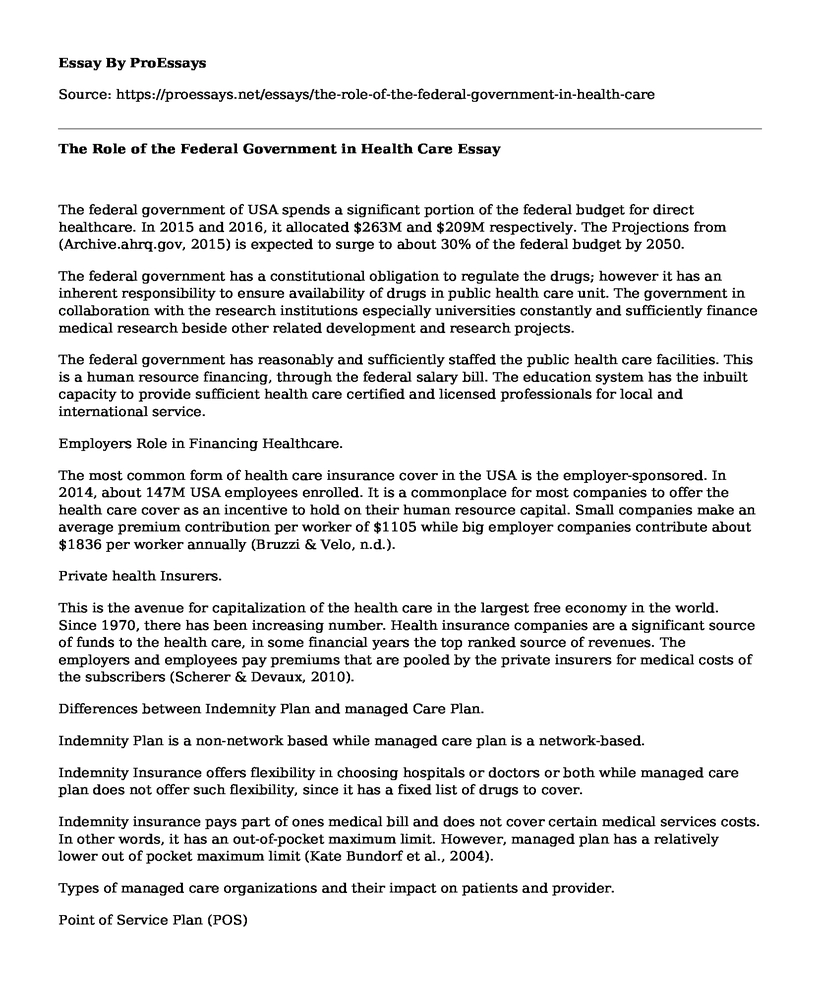The federal government of USA spends a significant portion of the federal budget for direct healthcare. In 2015 and 2016, it allocated $263M and $209M respectively. The Projections from (Archive.ahrq.gov, 2015) is expected to surge to about 30% of the federal budget by 2050.
The federal government has a constitutional obligation to regulate the drugs; however it has an inherent responsibility to ensure availability of drugs in public health care unit. The government in collaboration with the research institutions especially universities constantly and sufficiently finance medical research beside other related development and research projects.
The federal government has reasonably and sufficiently staffed the public health care facilities. This is a human resource financing, through the federal salary bill. The education system has the inbuilt capacity to provide sufficient health care certified and licensed professionals for local and international service.
Employers Role in Financing Healthcare.
The most common form of health care insurance cover in the USA is the employer-sponsored. In 2014, about 147M USA employees enrolled. It is a commonplace for most companies to offer the health care cover as an incentive to hold on their human resource capital. Small companies make an average premium contribution per worker of $1105 while big employer companies contribute about $1836 per worker annually (Bruzzi & Velo, n.d.).
Private health Insurers.
This is the avenue for capitalization of the health care in the largest free economy in the world. Since 1970, there has been increasing number. Health insurance companies are a significant source of funds to the health care, in some financial years the top ranked source of revenues. The employers and employees pay premiums that are pooled by the private insurers for medical costs of the subscribers (Scherer & Devaux, 2010).
Differences between Indemnity Plan and managed Care Plan.
Indemnity Plan is a non-network based while managed care plan is a network-based.
Indemnity Insurance offers flexibility in choosing hospitals or doctors or both while managed care plan does not offer such flexibility, since it has a fixed list of drugs to cover.
Indemnity insurance pays part of ones medical bill and does not cover certain medical services costs. In other words, it has an out-of-pocket maximum limit. However, managed plan has a relatively lower out of pocket maximum limit (Kate Bundorf et al., 2004).
Types of managed care organizations and their impact on patients and provider.
Point of Service Plan (POS)
A primary physicians organize the patient care; the patient is permitted to have a specified doctor. It is an integration of the Health Maintenance Organization (HMO) and indemnity plan. The indemnity coverage offered under POS from HMOs conventionally incorporates higher deductibles and coinsurance to buoy up subscribers to use the alternative HMO within network other than out-of-plan option. Subscribers are subject to utilization review.
Preferred Provider Organization (PPO)
These are entities that use the pooled employers health benefits and health insurance carriers that enter into a purchasing contract of health services for its subscribers. Unlike HMO, PPO subscribers are allowed to use non-PPO providers. However, higher deductions apply to the use of Non-PPO service providers. PPO are both comprehensive and specialty such as Dental, Chiropractic, and open heart surgery among others. PPO Offers negotiable payment rates. PPOs have a utilization management program like that of POS. They as well offer consumer choice, unlike the traditional HMO plan (Kate Bundorf et al., 2004).
Health Maintenance Organization (HMOs)
Principally responsible for delivery of broad-range comprehensive health care services to the subscribers and its financing. It is an interplay of the health care delivery management system (HCDMS) and the health insurers (HI). This plan provides health services to its subscribers through associated providers, who are reimbursed, it may be based on open access plan or closed.
References
Archive.ahrq.gov,. (2015). Questions and Answers About Health Insurance (continued). Retrieved 17 December 2015, from http://archive.ahrq.gov/consumer/insuranceqa/insuranceqa5.htm
Bruzzi, S., & Velo, D. Health care systems in a changing society and a changing State.
Kate Bundorf, M., Schulman, K., Stafford, J., Gaskin, D., Jollis, J., & Escarce, J. (2004). Impact of Managed Care on the Treatment, Costs, and Outcomes of Fee-for-Service Medicare Patients with Acute Myocardial Infarction. Health Serv Res, 39(1), 131-152. http://dx.doi.org/10.1111/j.1475-6773.2004.00219.x
Scherer, P., & Devaux, M. (2010). The Challenge of Financing Health Care in the Current Crisis. Paris: OECD Publishing.
Cite this page
The Role of the Federal Government in Health Care. (2021, Mar 01). Retrieved from https://proessays.net/essays/the-role-of-the-federal-government-in-health-care
If you are the original author of this essay and no longer wish to have it published on the ProEssays website, please click below to request its removal:
- Paper Example on Transfer Element in Successful Policies
- Aravind Eye Hospital Case Analysis Paper Example
- Doctors on DNA, Cancer, Renal Failure and Differential Hierarchy Paper Example
- Essay Sample on Interpreting the Constitution and Making Rulings by the Judges
- Medical Essay on Chest Pain
- Essay Example on UAP: An Essential Part of Nursing Care in Changing Healthcare
- Evidence-Based Practice: Validated Sources for Nurses' Skills & Knowledge - Essay Sample







